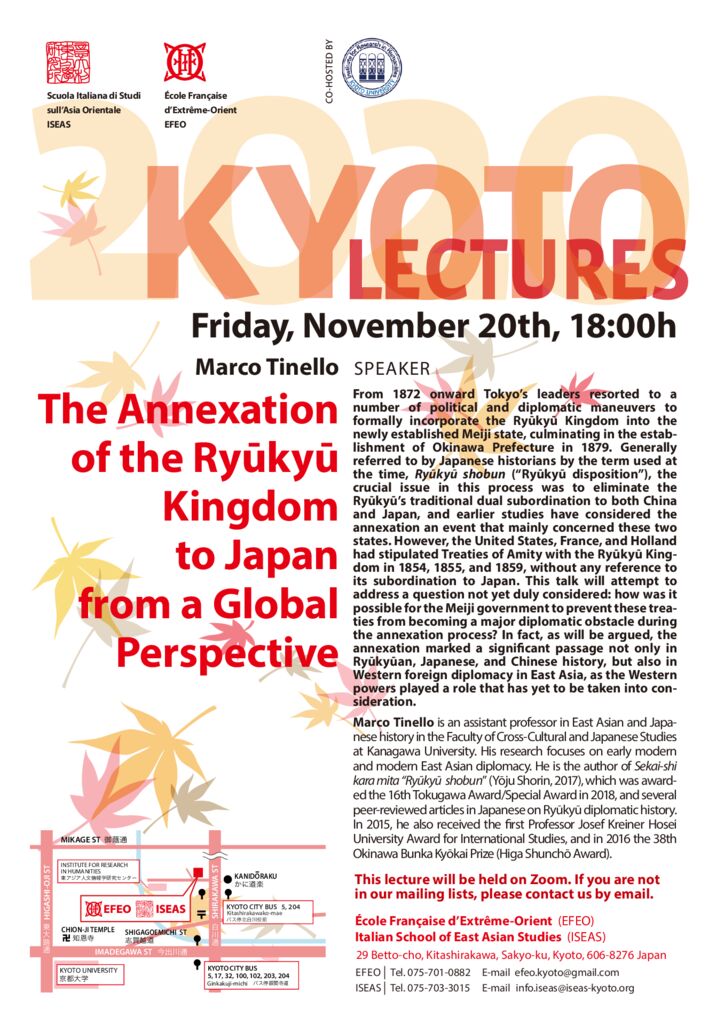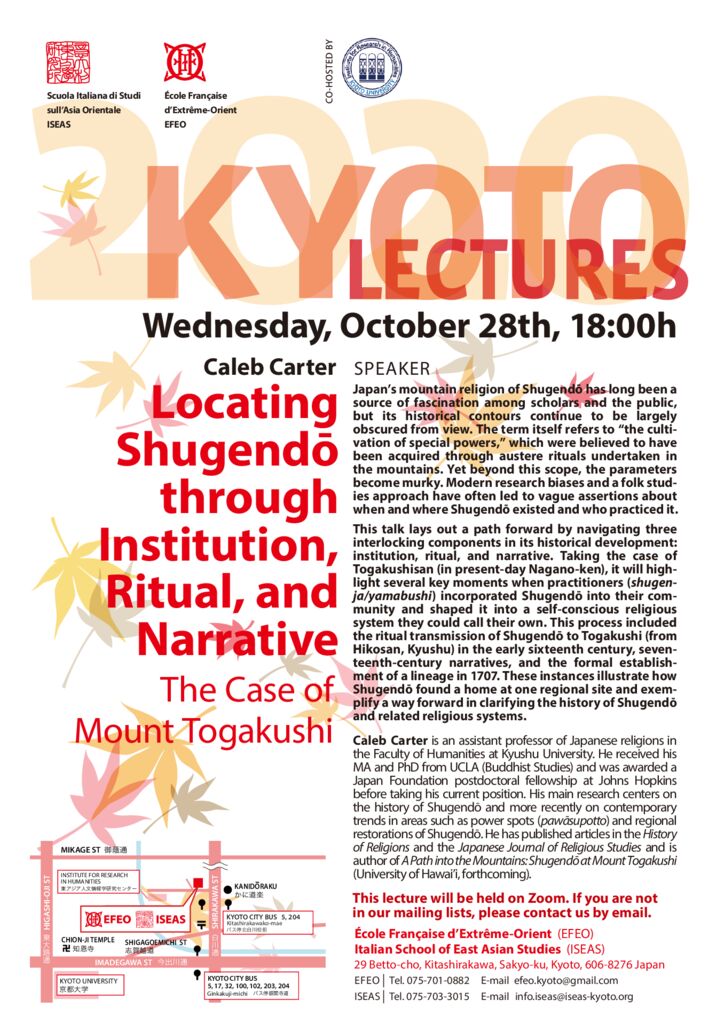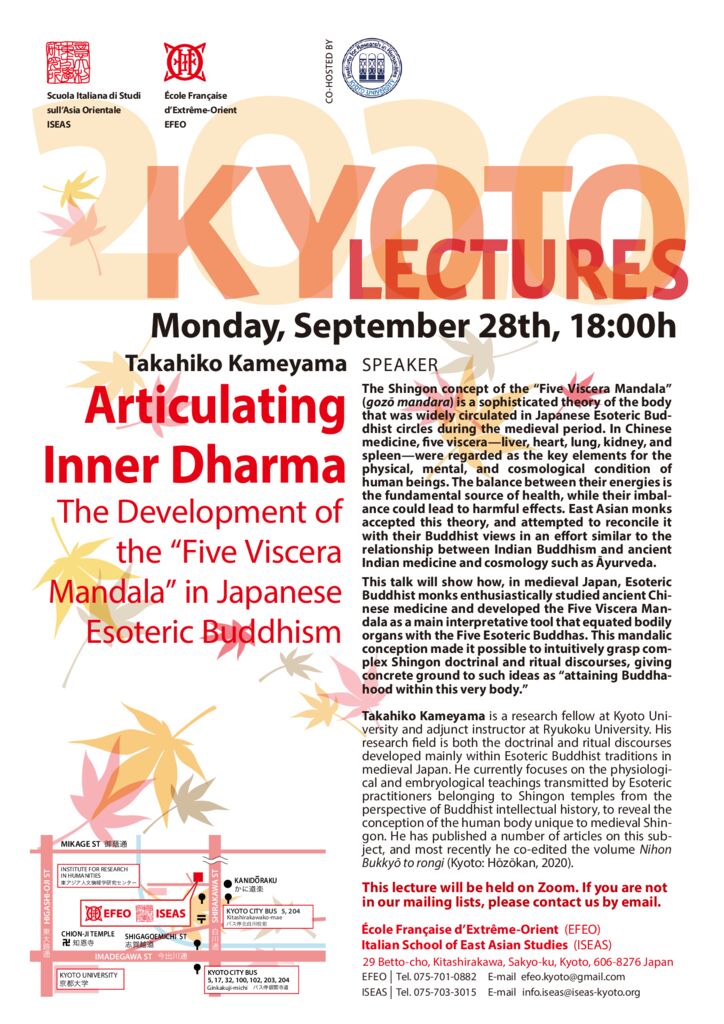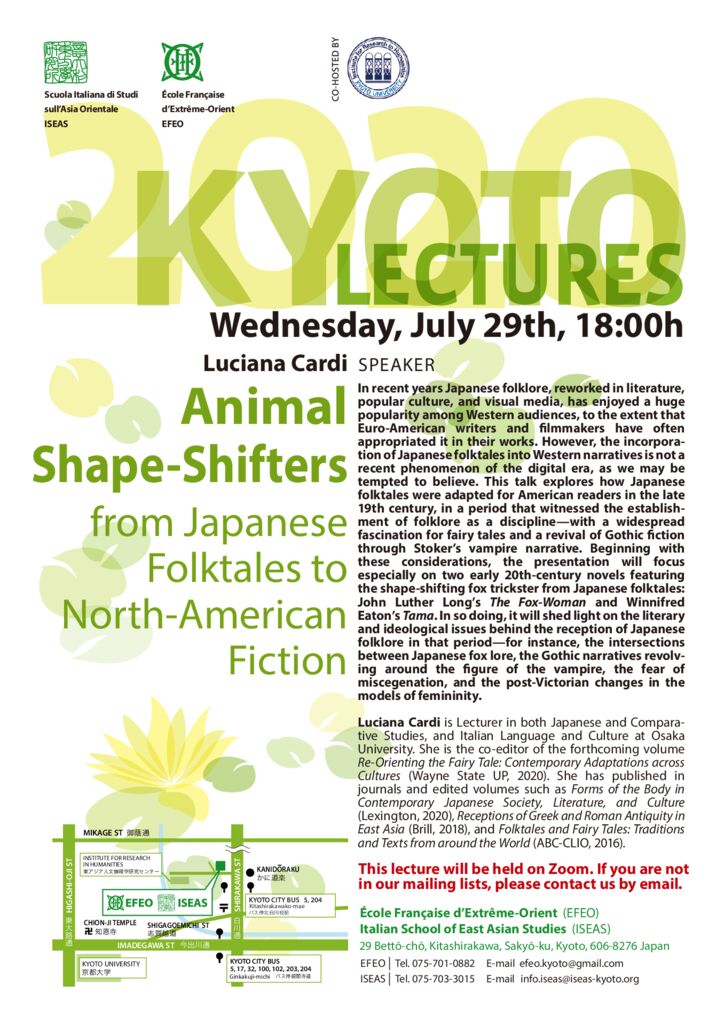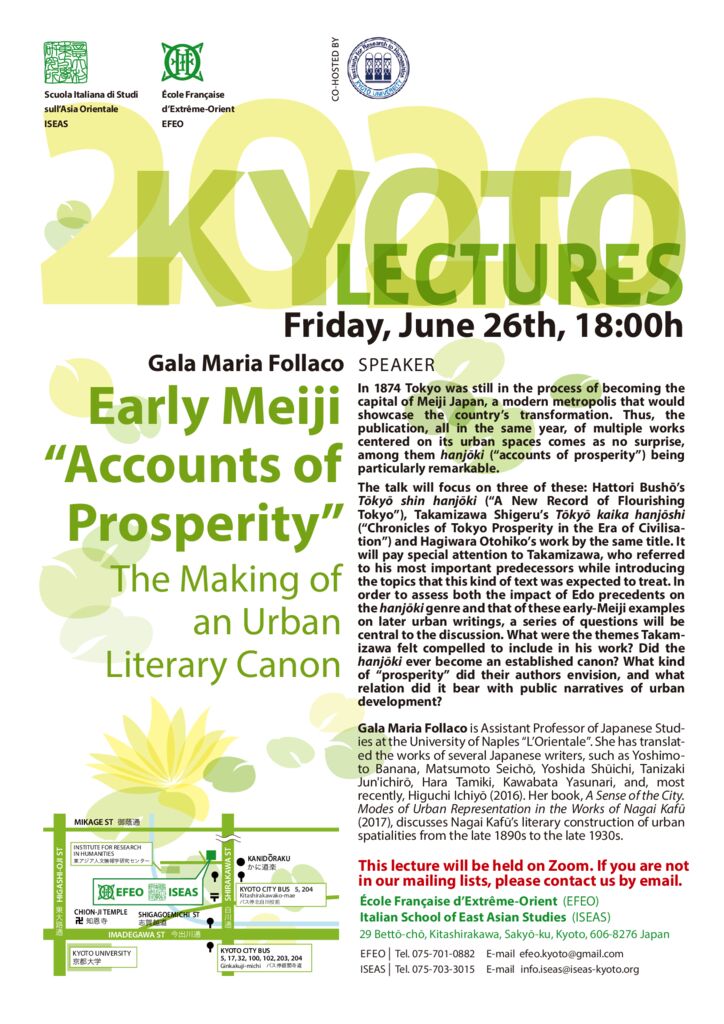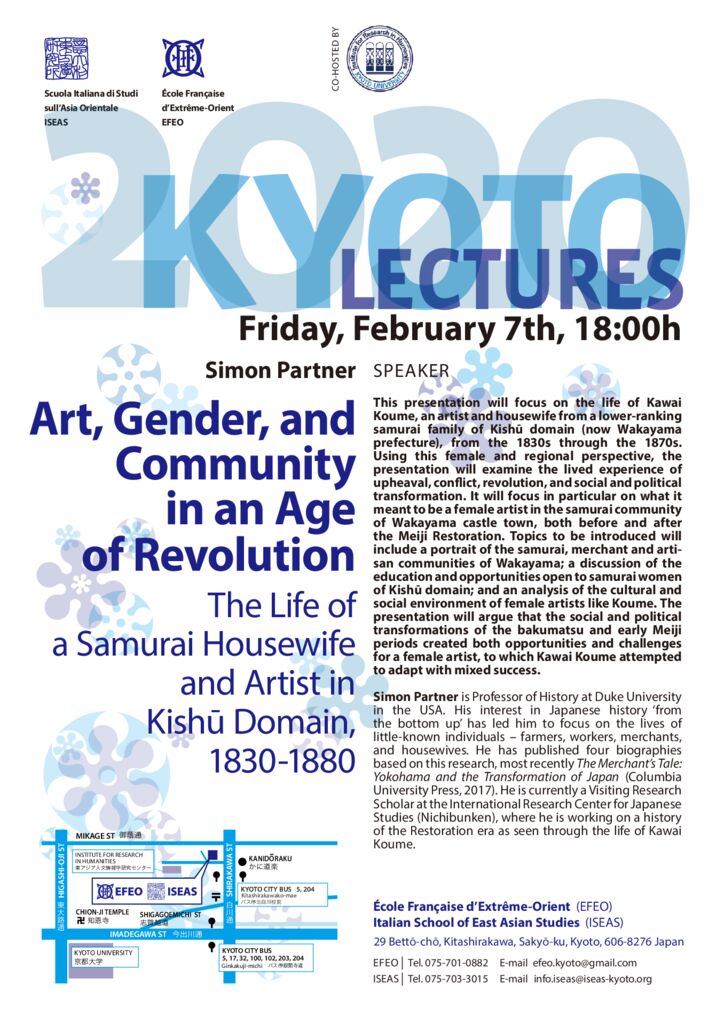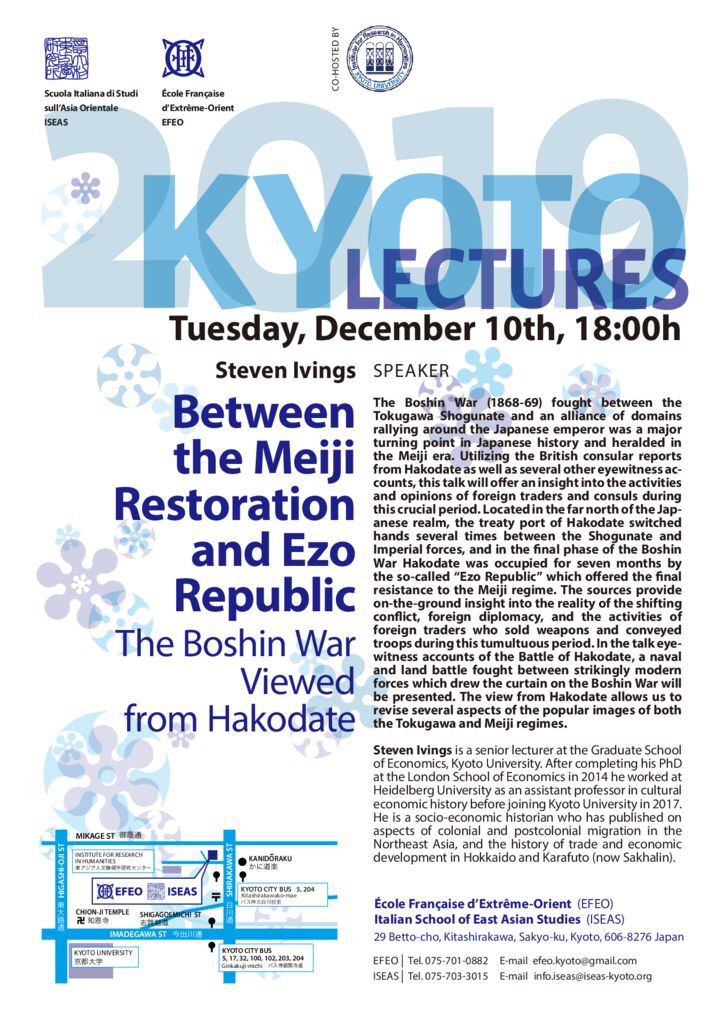Kyoto Lectures
The Annexation of the Ryūkyū Kingdom to Japan from a Global Perspective
Marco Tinello
November 20th, 2020 18:00
This lecture will be available only on Zoom
From 1872 onward Tokyo’s leaders resorted to a number of political and diplomatic maneuvers to formally incorporate the Ryūkyū Kingdom into the newly established Meiji state, culminating in the establishment of Okinawa Prefecture in 1879. Generally referred to by Japanese historians by the term used at the time, Ryūkyū shobun (“Ryūkyū disposition”), the crucial issue in this process was to eliminate the Ryūkyū’s traditional dual subordination to both China and Japan, and earlier studies have considered the annexation an event that mainly concerned these two states. However, the United States, France, and Holland had stipulated Treaties of Amity with the Ryūkyū Kingdom in 1854, 1855, and 1859, without any reference to its subordination to Japan. This talk will attempt to address a question not yet duly considered: how was it possible for the Meiji government to prevent these treaties from becoming a major diplomatic obstacle during the annexation process? In fact, as will be argued, the annexation marked a significant passage not only in Ryūkyūan, Japanese, and Chinese history, but also in Western foreign diplomacy in East Asia, as the Western powers played a role that has yet to be taken into consideration.
Marco Tinello is an assistant professor in East Asian and Japanese history in the Faculty of Cross-Cultural and Japanese Studies at Kanagawa University. His research focuses on early modern and modern East Asian diplomacy. He is the author of Sekai-shi kara mita “Ryūkyū shobun” (Yōju Shorin, 2017), which was awarded the 16th Tokugawa Award/Special Award in 2018, and several peer-reviewed articles in Japanese on Ryūkyū diplomatic history. In 2015, he also received the first Professor Josef Kreiner Hosei University Award for International Studies, and in 2016 the 38th Okinawa Bunka Kyōkai Prize (Higa Shunchō Award).
Kyoto Lectures
Locating Shugendō through Institution, Ritual, and Narrative
The Case of Mount Togakushi
Caleb Carter
October 28th, 2020 18:00
This lecture will be available only on Zoom
Japan’s mountain religion of Shugendō has long been a source of fascination among scholars and the public, but its historical contours continue to be largely obscured from view. The term itself refers to “the cultivation of special powers,” which were believed to have been acquired through austere rituals undertaken in the mountains. Yet beyond this scope, the parameters become murky. Modern research biases and a folk studies approach have often led to vague assertions about when and where Shugendō existed and who practiced it.
This talk lays out a path forward by navigating three interlocking components in its historical development: institution, ritual, and narrative. Taking the case of Togakushisan (in present-day Nagano-ken), it will highlight several key moments when practitioners (shugenja/yamabushi) incorporated Shugendō into their community and shaped it into a self-conscious religious system they could call their own. This process included the ritual transmission of Shugendō to Togakushi (from Hikosan, Kyushu) in the early sixteenth century, seventeenth-century narratives, and the formal establishment of a lineage in 1707. These instances illustrate how Shugendō found a home at one regional site and exemplify a way forward in clarifying the history of Shugendō and related religious systems.
Caleb Carter is an assistant professor of Japanese religions in the Faculty of Humanities at Kyushu University. He received his MA and PhD from UCLA (Buddhist Studies) and was awarded a Japan Foundation postdoctoral fellowship at Johns Hopkins before taking his current position. His main research centers on the history of Shugendō and more recently on contemporary trends in areas such as power spots (pawāsupotto) and regional restorations of Shugendō. He has published articles in the History of Religions and the Japanese Journal of Religious Studies and is author of A Path into the Mountains: Shugendō at Mount Togakushi (University of Hawai’i, forthcoming).
Kyoto Lectures
Articulating Inner Dharma
The Development of the “Five Viscera Mandala” in Japanese Esoteric Buddhism
Takahiko Kameyama
September 28th, 2020 18:00
The Shingon concept of the “Five Viscera Mandala” (gozô mandara) is a sophisticated theory of the body that was widely circulated in Japanese Esoteric Buddhist circles during the medieval period. In Chinese medicine, five viscera—liver, heart, lung, kidney, and spleen—were regarded as the key elements for the physical, mental, and cosmological condition of human beings. The balance between their energies is the fundamental source of health, while their imbalance could lead to harmful effects. East Asian monks accepted this theory, and attempted to reconcile it with their Buddhist views in an effort similar to the relationship between Indian Buddhism and ancient Indian medicine and cosmology such as Âyurveda.
This talk will show how, in medieval Japan, Esoteric Buddhist monks enthusiastically studied ancient Chinese medicine and developed the Five Viscera Mandala as a main interpretative tool that equated bodily organs with the Five Esoteric Buddhas. This mandalic conception made it possible to intuitively grasp complex Shingon doctrinal and ritual discourses, giving concrete ground to such ideas as “attaining Buddhahood within this very body.”
Takahiko Kameyama is a research fellow at Kyoto University and adjunct instructor at Ryukoku University. His research field is both the doctrinal and ritual discourses developed mainly within Esoteric Buddhist traditions in medieval Japan. He currently focuses on the physiological and embryological teachings transmitted by Esoteric practitioners belonging to Shingon temples from the perspective of Buddhist intellectual history, to reveal the conception of the human body unique to medieval Shingon. He has published a number of articles on this subject, and most recently he co-edited the volume Nihon Bukkyô to rongi (Kyoto: Hôzôkan, 2020).
This lecture will be available on Zoom. A limited audience (maximum ten persons, with precedence to researchers and advanced students) will be allowed at our centre. For this, please contact us by e-mail.
Kyoto Lectures
Animal Shape-Shifters
from Japanese Folktales to North-American Fiction
Luciana Cardi
July 29th, 2020 18:00
This lecture will be available only on Zoom
In recent years Japanese folklore, reworked in literature, popular culture, and visual media, has enjoyed a huge popularity among Western audiences, to the extent that Euro-American writers and filmmakers have often appropriated it in their works. However, the incorporation of Japanese folktales into Western narratives is not a recent phenomenon of the digital era, as we may be tempted to believe. This talk explores how Japanese folktales were adapted for American readers in the late 19th century, in a period that witnessed the establishment of folklore as a discipline—with a widespread fascination for fairy tales and a revival of Gothic fiction through Stoker’s vampire narrative. Beginning with these considerations, the presentation will focus especially on two early 20th-century novels featuring the shape-shifting fox trickster from Japanese folktales: John Luther Long’s The Fox-Woman and Winnifred Eaton’s Tama. In so doing, it will shed light on the literary and ideological issues behind the reception of Japanese folklore in that period-for instance, the intersections between Japanese fox lore, the Gothic narratives revolving around the figure of the vampire, the fear of miscegenation, and the post-Victorian changes in the models of femininity.
Luciana Cardi is Lecturer in both Japanese and Comparative Studies, and Italian Language and Culture at Osaka University. She is the co-editor of the forthcoming volume Re-Orienting the Fairy Tale: Contemporary Adaptations across Cultures (Wayne State UP, 2020). She has published in journals and edited volumes such as Forms of the Body in Contemporary Japanese Society, Literature, and Culture (Lexington, 2020), Receptions of Greek and Roman Antiquity in East Asia (Brill, 2018), and Folktales and Fairy Tales: Traditions and Texts from around the World (ABC-CLIO, 2016).
Kyoto Lectures
Early Meiji “Accounts of Prosperity”
The Making of an Urban Literary Canon
Gala Maria Follaco
June 26th, 2020 18:00
This lecture will be available only on Zoom
In 1874 Tokyo was still in the process of becoming the capital of Meiji Japan, a modern metropolis that would showcase the country’s transformation. Thus, the publication, all in the same year, of multiple works centered on its urban spaces comes as no surprise, among them hanjôki (“accounts of prosperity”) being particularly remarkable.
The talk will focus on three of these: Hattori Busho’s Tôkyô shin hanjôki (“A New Record of Flourishing Tokyo”), Takamizawa Shigeru’s Tôkyô kaika hanjôshi (“Chronicles of Tokyo Prosperity in the Era of Civilisation”) and Hagiwara Otohiko’s work by the same title. It will pay special attention to Takamizawa, who referred to his most important predecessors while introducing the topics that this kind of text was expected to treat. In order to assess both the impact of Edo precedents on the hanjôki genre and that of these early-Meiji examples on later urban writings, a series of questions will be central to the discussion. What were the themes Takamizawa felt compelled to include in his work? Did the hanjôki ever become an established canon? What kind of “prosperity” did their authors envision, and what relation did it bear with public narratives of urban development?
Gala Maria Follaco is Assistant Professor of Japanese Studies at the University of Naples “L’Orientale”. She has translated the works of several Japanese writers, such as Yoshimoto Banana, Matsumoto Seicho, Yoshida Shuichi, Tanizaki Jun’ichiro, Hara Tamiki, Kawabata Yasunari, and, most recently, Higuchi Ichiyo (2016). Her book, A Sense of the City. Modes of Urban Representation in the Works of Nagai Kafu (2017), discusses Nagai Kafu’s literary construction of urban spatialities from the late 1890s to the late 1930s.
Kyoto Lectures
Japan’s Ocean Borderlands
Nature and Sovereignty
Paul Kreitman
May 27th, 2020 18:00
This lecture will be available only on Zoom
Some of Japan’s most far-flung islands are also its smallest: tiny specks of rocks surrounded by storm-tossed oceans, covered only in birds and bird shit, and yet freighted with political, economic and symbolic importance out of all proportion to their size. But how did these islands come to be Japanese in the first place? And how have they remained so?
Most of Japan’s outlying islands were first annexed during the late nineteenth century, when a motley crew of bird hunters and guano prospectors convinced the government that they would make viable sites for colonisation. Yet all attempts at settlement eventually failed, and since the end of World War II ornithologists have lobbied for the abandoned islands to be turned into nature reserves instead. To do so, they have tapped into broader postwar anxieties about territorial loss and Japan’s place in the global order – concerns that reverberate to this day. In this talk I explore how attempts to shape the environments of remote islands such as Izu-Torishima, the Northwest Hawaiian Islands and the Diaoyu/Senkaku/Islands have also helped shape the contested borders of the modern Japanese state.
Paul Kreitman is Assistant Professor of 20th Century Japanese History in the Department of East Asian Languages and Cultures at Columbia University. He received his PhD from Princeton in 2015, and is currently completing a monograph on the environmental history of Japan’s desert islands, slated for publication with Cambridge University Press in 2021. An extract from his second project, on the political ecology of excrement in wartime Japan, has been published in Environmental History. His writing has also appeared in The Japan Times, The New Statesman and The Diplomat.
Kyoto Lectures
Gesaku Literati and Early Meiji Print Culture
Remaking Popular Culture for the Masses
Alistair Swale
April 22nd, 2020 18:00
This lecture will be available only on Zoom
The Meiji Restoration of 1868 set in train a major reconfiguration of not only the political structure of government but also the world of letters, aecting not just academic elites but also the demimonde literati and artists (gesakusha) who had enjoyed various forms of patronage under the Tokugawa regime.
This talk aims to expand the understanding of the practices relevant to gesaku in the early Meiji period by exploring the profound overlap between text, image and oral performance as well as the significance of the traditions of rakugo and kôdan in the early literary scene. The presentation also reviews the initiatives of early Meiji gesakusha who, in collaboration with nishiki-e artists such as Ochiai Yoshiiku and Tsukioka Yoshitoshi, spearheaded the development of a distinctive genre of illustrated news, nishiki-e shinbun.
Finally, some attention will be given to the continued adaptation of this mode of collaboration in the minor newspaper format, particularly as seen in the Tokyo Eiri Shinbun, established in 1875, and later illustrated newspapers associated with the Popular Rights Movement such as the Eiri Chôya Shinbun and the Jiyû no Tomoshibi.
Alistair Swale is an Associate Professor in Japanese at the University of Canterbury, New Zealand. He has written on the career and thought of Mori Arinori, as well as more broadly on the Restoration in The Meiji Restoration: Monarchism, Mass Communication and Conservative Revolution (Palgrave 2009). More recently he has been engaged in collaborative research at the International Research Center for Japanese Studies in Kyoto where he is completing a year-long project examining responses in popular culture to the “Civilization and Enlightenment” movement.
Kyoto Lectures
Art, Gender, and Community in an Age of Revolution
The Life of a Samurai Housewife and Artist in Kishu Domain, 1830-1880
Simon Partner
February 7th, 2020 18:00
Italian School of East Asian Studies
This presentation will focus on the life of Kawai Koume, an artist and housewife from a lower-ranking samurai family of Kishu domain (now Wakayama prefecture), from the 1830s through the 1870s. Using this female and regional perspective, the presentation will examine the lived experience of upheaval, conict, revolution, and social and political transformation. It will focus in particular on what it meant to be a female artist in the samurai community of Wakayama castle town, both before and after the Meiji Restoration. Topics to be introduced will include a portrait of the samurai, merchant and artisan communities of Wakayama; a discussion of the education and opportunities open to samurai women of Kishu domain; and an analysis of the cultural and social environment of female artists like Koume. The presentation will argue that the social and political transformations of the bakumatsu and early Meiji periods created both opportunities and challenges for a female artist, to which Kawai Koume attempted to adapt with mixed success.
Simon Partner is Professor of History at Duke University in the USA. His interest in Japanese history ‘from the bottom up’ has led him to focus on the lives of little-known individuals – farmers, workers, merchants, and housewives. He has published four biographies based on this research, most recently The Merchant’s Tale: Yokohama and the Transformation of Japan (Columbia University Press, 2017). He is currently a Visiting Research Scholar at the International Research Center for Japanese Studies (Nichibunken), where he is working on a history of the Restoration era as seen through the life of Kawai Koume.
Kyoto Lectures
Environmental Expertise in Modern Japan and the Ashio Copper Mine Case
Cyrian Pitteloud
January 29th, 2020 18:00
Italian School of East Asian Studies
The Ashio copper mine incident is one of Japan’s first and most famous industrial pollution cases. An industrialist close to the government took charge of the mine in the Tochigi Prefecture mountains at the end of the 1870s. The mine was modernized and extensively worked until, less than fifteen years later, it was fulfilling a third of the nation’s copper needs. The exploitation of this copper deposit on an industrial scale lead to environmental contamination that spread across five prefectures. In response, a protest movement arose that lasted for almost two decades.
The protest movement forms the major part of the case’s historiography. However, while benefiting from its findings, this talk will rather concentrate on the government and the measures it took to handle the social and ecological crisis. Among others, the establishment of pollution investigation committees in 1897 and 1902 is particularly informative, as the process of legitimization towards a public opinion increasingly aware of the events leant largely on data gathered and created by the ocial representatives of fast-growing disciplines (agronomy, medicine, engineering, etc.). Despite its importance, such process of legitimisation-by-scientific- knowledge has been, until now, barely studied.
Cyrian Pitteloud is a research fellow at the University of Geneva and at the École Française d’Extrême Orient in Kyoto. He studied History and Japanese studies at both Geneva and Lausanne universities, and, from 2012 to 2019, he was teaching assistant at the Japanese Unit of the University of Geneva. In November 2019, he completed his Ph.D. He has published a few articles and book chapters about the protest movement against the pollution of the Ashio copper mine, and translated various primary sources in Souyri P. F. (ed.), Japon colonial 1880-1930. Les voix de la dissension, ed. Belles-lettres, 2014.
Kyoto Lectures
Between the Meiji Restoration and Ezo Republic
The Boshin War Viewed from Hakodate
Steven Ivings
December 10th, 2019 18:00
Italian School of East Asian Studies
The Boshin War (1868-69) fought between the Tokugawa Shogunate and an alliance of domains rallying around the Japanese emperor was a major turning point in Japanese history and heralded in the Meiji era. Utilizing the British consular reports from Hakodate as well as several other eyewitness accounts, this talk will offer an insight into the activities and opinions of foreign traders and consuls during this crucial period. Located in the far north of the Japanese realm, the treaty port of Hakodate switched hands several times between the Shogunate and Imperial forces, and in the final phase of the Boshin War Hakodate was occupied for seven months by the so-called “Ezo Republic” which offered the final resistance to the Meiji regime. The sources provide on-the-ground insight into the reality of the shifting conflict, foreign diplomacy, and the activities of foreign traders who sold weapons and conveyed troops during this tumultuous period. In the talk eyewitness accounts of the Battle of Hakodate, a naval and land battle fought between strikingly modern forces which drew the curtain on the Boshin War will be presented. The view from Hakodate allows us to revise several aspects of the popular images of both the Tokugawa and Meiji regimes.
Steven Ivings is a senior lecturer at the Graduate School of Economics, Kyoto University. After completing his PhD at the London School of Economics in 2014 he worked at Heidelberg University as an assistant professor in cultural economic history before joining Kyoto University in 2017. He is a socio-economic historian who has published on aspects of colonial and postcolonial migration in the Northeast Asia, and the history of trade and economic development in Hokkaido and Karafuto (now Sakhalin).
